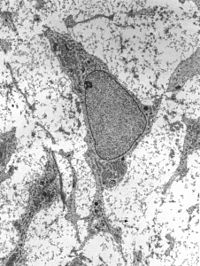
Photo from wikipedia
Cellular mechanisms whereby quiescent stem cells sense tissue injury and transition to an activated state are largely unknown. Quiescent skeletal muscle stem cells (MuSCs, also called satellite cells) have elaborate,… Click to show full abstract
Cellular mechanisms whereby quiescent stem cells sense tissue injury and transition to an activated state are largely unknown. Quiescent skeletal muscle stem cells (MuSCs, also called satellite cells) have elaborate, heterogeneous projections that rapidly retract in response to muscle injury. They may therefore act as direct sensors of their niche environment. Retraction is driven by a Rac‐to‐Rho GTPase activity switch that promotes downstream MuSC activation events. These and other observations lead to several hypotheses: (1) projections are morphologically dynamic at quiescence, providing a surveillance function for muscle damage; (2) quiescent projection dynamics are regulated by the relative balance of Rac and Rho activities promoted by niche‐derived cues; (3) projections, particularly their associated filopodia, sense tissue damage via changes to the biomechanical properties of the niche and/or detection of signaling cues released by damaged myofibers; and (4) the dynamic nature of projections results in a population of MuSCs with heterogeneous functional properties. These concepts may extend to other types of quiescent stem cells, as well as prove useful in translational research settings.
Journal Title: BioEssays
Year Published: 2023
Link to full text (if available)
Share on Social Media: Sign Up to like & get
recommendations!